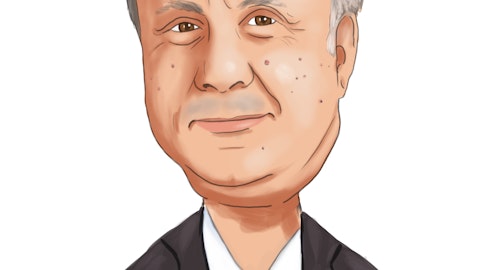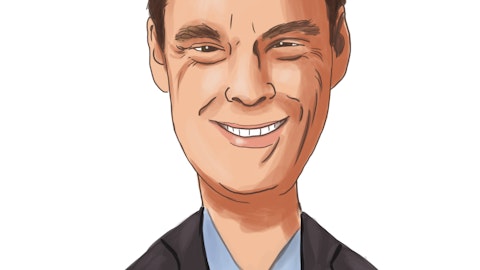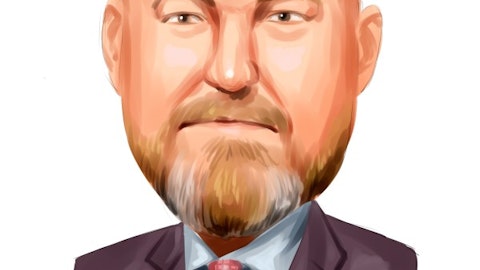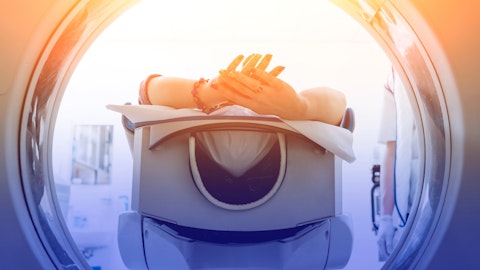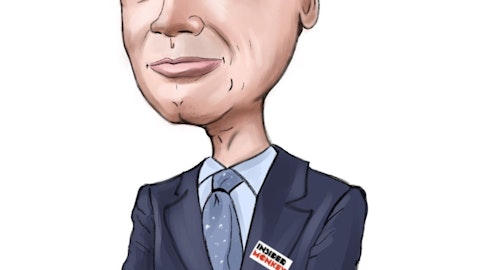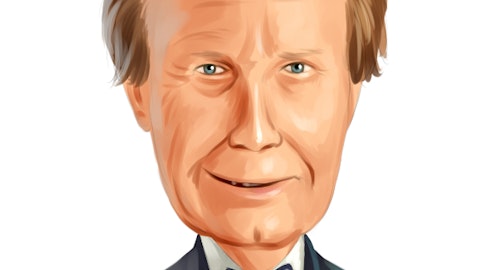Steven Lichtman: I wanted to ask a little bit about NanoKnife. We’ve had strong disposable sales profile and effect from the ongoing studies How much of a runway do you guys see for that continuing after trial enrollment complete and before you get indication expansion
Jim Clemmer: So good question. So if you look back at last fiscal year, we guided about 20% disposable growth and we overachieved that. This year, again, we guided about 20% disposable growth and we’re overachieving that as well. So we think it’s due to — some of it is the halo effect from the DIRECT study on the pancreatic cancer patients and now are PRESERVE. People are just getting more awareness about how NanoKnife works, why it’s so special and can treat very delicate organs in a unique manner. So I think that when there’s more awareness generated, I think there’s more interest generated, we’re seeing more inbound interest from physicians, and we’re able to train them properly, let them choose how they want to treat and where they treat while we’re committed to getting the data published to prove these sources can be areas.
We also know, as we identified, when we complete enrollment and complete the final study 12 months later on preserve, we believe that we’ll open up about a $700 million market in the U.S. for those intermediate risk patients, give them a chance for a good focal treatment. So it’s going to be a combination of a few factors. We think we’ll continue to grow the business at about this rate up until we get that indication end of next year, and we’ll give you more guidance there is what we can do. We’re trying to align the indication of regulatory approvals with reimbursement and then patient and customer awareness. And when we do those together, we really think we have a special product that can grow in this market.
Steven Lichtman: And then my other question was about Auryon. You guys have said that you got feedback from docs that they want it and you’re pressuring that opportunity. But this is pretty new in the field. Can you let us know a little bit about how that development process is unfolding? Have you wished to point where you can say this receivable and definitely going to be followed through?
Jim Clemmer: Yes. So let me take a swing at it. If I get your question wrong, please stop me or chime in again. So we’re hearing a lot of great feedback. Again, we launched Auryon in September of 2020 when the pandemic hit, and we are rolling out this product. And there’s good competitors in the field, They’re effective systems out there. But we knew our is different. And the physician feedback we received from that date has been really tremendous. So we also told our physicians, this is a platform technology. We’re going to grow what we do first in PAD and atherectomy. And we’ve done that already with the hydrophilic coating catheters we launched this year. Later this calendar year, we’re looking to launch radio products, give our physicians a new access point, a new way to use our atherectomy tools, a new way to use Auryon in the anatomy.
So we’ll continue to develop not just the products but we’re also working with the science behind it. You’ve seen and we’ll see during the course of this year more publications driven by some of our physicians who believe in the science and have seen unique elements of how it treats the anatomy. We’re also committed, as you know, we believe that Auryon will complement a mechanical thrombectomy platform with an Auryon version, a mechanical thrombectomy, coming to the end of calendar year 2024 for small vessel DVT, utilizing the power and energy that Auryon delivers and the safety efficacy within the vessel wall in a manner that we believe will give physicians a new way to treat thrombectomy.
Operator: Our next questions come from the line of Jayson Bedford with Raymond James. Please proceed with your question.
Jayson Bedford: I guess just a few questions. Maybe to start on gross margin. I understand some of the headwinds, but I’m a bit surprised at the acute nature of some of the inflationary dynamics, meaning Med Device gross margin kind of down quarter-on-quarter, down year-over-year. Is there anything what was new that popped up more on the Med Device gross margin side in the quarter?
Steve Trowbridge: Jayson, this is Steve. Jim had mentioned in his prepared remarks, some of the disruption that we’re seeing from some of our supply chain partners and our component suppliers. That has been part of it. As we mentioned, there’s about $1.5 million of components that we were expecting to get in that would have allowed us to get about $3 million of revenue out in the quarter. They were scheduled to be earlier in the quarter. We were told that they were going to be pushed out. We do expect those to come into Q4. So some of that was tied up in terms of the WIP and coming from the supply chain disruption. And the other piece really is the raw material inflation. As we’ve talked about, specifically in the device business, we’ve got a large number of SKUs in that business all throughout the different products that are there.
And we’re just not the largest purchaser for most of our suppliers. And so as the macro environment continues, we’re finding that we’re a little bit in the middle of the line there, not enough to really drive extensive volume benefits. We’re not at the end of the line, but at the same time, dealing with some of those price increases, which we found to be stickier this year than we were expecting in the summer and will probably extend a little bit into the next year as well. And we’re going to — we expect that’s going to happen as we build into the thinking about the next year. So those raw material components have driven a big part of that as well as just some of the timing and mix of turning product into finished goods and getting them out the door.
Jayson Bedford: And the $3 million that was lost here or pushed out here loss is probably not the right word, but the $3 million that you mentioned, that will all benefit the fourth quarter. Is that the expectation?
Steve Trowbridge: We definitely expected to clear the fourth quarter. Now there may be — we don’t expect it to be at that same level. But as we said, it’s not like the component supplier issues are going to completely vanish. We’re going to be dealing with component supplier issues for a while. And our team is managing that on a day-to-day basis. But yes, we do expect those to clear into the fourth quarter.
Jayson Bedford: And just on the backlog, I think you talked about a little over $5 million in total. Is the math here into it with a reduction of $3 million from the last quarter, but you added another $3 million. Is that kind of the math on it?
Steve Trowbridge: The timing that you’re talking about is the right way to think of it. So if you think about where the back order stood at the end of the quarter, although the numbers were relatively consistent from the end of Q2 to Q3, the mix of that was very different. And so the way you described it is exactly right. We were eating into it clearing it kind of at the same pace that we had been over the past few quarters. And then some of the timing on the component supply means that you end up with a different mix at the end of the quarter.
Jayson Bedford: Maybe just switching gears to the other dynamic here in the quarter. AngioVac I guess, the question for me is, do you have fewer users in the technology? Or do you have the same number of users just using it for fewer cases? If that question makes sense.
